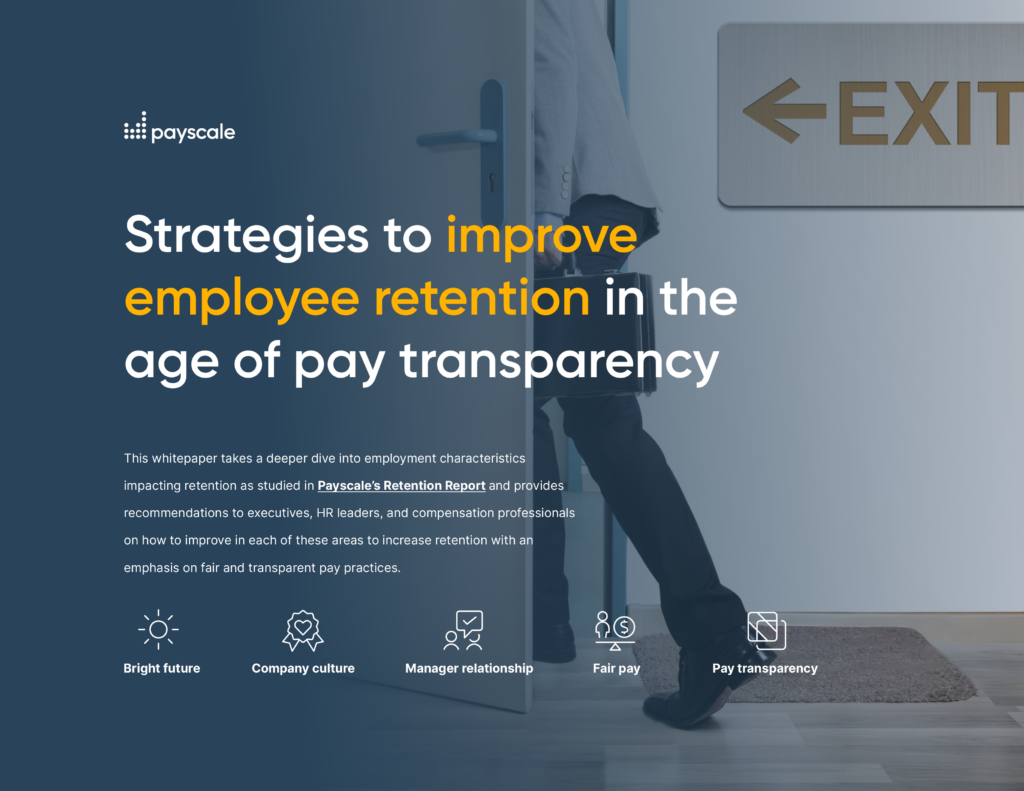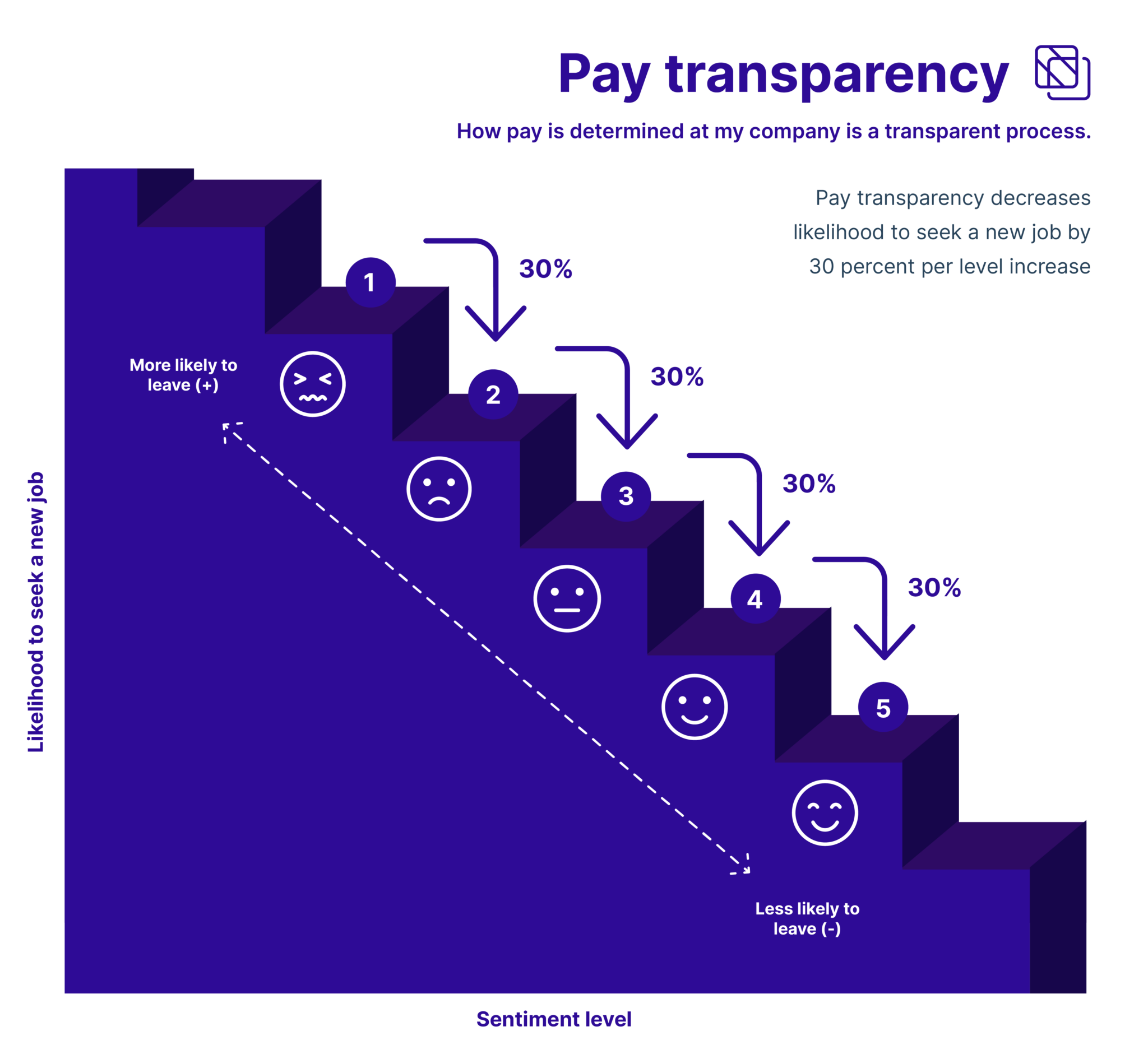Recently released research from Payscale finds that pay transparency is correlated with decreased likelihood that employees will seek a new job.
This is excellent news for employers, who have been increasingly nervous about expanding pay transparency legislation requiring them to publish pay ranges to job advertisements. Although publishing pay ranges has been shown to increase applications — and indeed, 80 percent of employees won’t apply to jobs where the pay range is not disclosed — employers have been understandably nervous that pay transparency might unsettle or upset current employees. .
The research shows that pay transparency is good for employee retention overall.
To determine the impact of pay transparency, Payscale’s online salary survey made the statement, “How pay is determined at my company is a transparent process,” and asked respondents to score their organization on a Likert Scale of one through five, where one is “strongly disagree” and five is “strongly agree.” The survey also asked if respondents will be looking for a job in the next six months.
The phrasing of the pay transparency question is intentionally broad as pay transparency means different things to different organizations. The research analyzed responses from over half a million participants, which translates to robust data with high confidence in the findings. The overall intent was to determine whether pay transparency has a positive or negative correlation with intent to leave.
A logistic regression was used to correlate the responses along the one to five sentiment level with intent to leave (yes or no). The analysis finds that intent to leave decreases as pay transparency increases. Respondents who scored their organization as a four or five on the transparency of pay processes are far less likely to be seeking a new job compared to respondents who scored their organization’s pay transparency as a one or two. On average, pay transparency has a 30 percent chance of decreasing intent to leave across sentiment levels.
These results should be a relief to organizations grappling with the potential consequences of pay transparency.
Overall, pay transparency is good business. However, there are some caveats.
Posting pay ranges to job ads alone is insufficient as a best practice for increasing retention. This is because there is a natural connection between pay transparency and fair pay perception. Unfortunately, not every organization is transparent about pay practices, even if they publish pay ranges. That’s because not every organization has invested in pay strategy and pay communications to ensure that pay practices are fair and that employees understand why pay is fair.
The importance of pay strategy and pay communications can’t be overlooked. For example, Payscale’s research found that Generation Z is 3 percent more likely to seek a new job when pay is transparent. This is because younger workers are frequently paid less. They are also less likely to understand pay practices and more likely to become frustrated when pay increases are slow, low, or non-existent. This is especially true if younger workers discover that they are paid below the midpoint, or even just not at the top of the range, which they may expect due to a lack of understanding around how compensation is determined and managed.
And, of course, many organizations do not have a compensation strategy that is adequate to provide an explanation. According to Payscale’s Compensation Best Practices Report, only 55 percent of organizations have a compensation strategy, only 63 percent say that pay equity is a current or planned initiative, and only 49 percent train managers on pay communications.
That last one is critical. If you want pay transparency to reduce turnover, especially amongst younger workers, you need to empower managers to have effective conversations with employees who feel underpaid relative to their peers. But, of course, organizations that don’t have a pay strategy (or aren’t confident in how it gets implemented) will likely be stymied in this effort.
Payscale’s research also studied the impact of pay transparency in comparison to other factors that affect retention, such as overall company outlook (bright future), fair pay, company culture, and manager relationship. Unsurprisingly, fair pay perception had a larger impact on intent to leave (27 percent) than pay transparency (1 percent) in a multivariate logistic regression analysis. Fair pay had the second-largest impact behind bright future (39 percent).
What this means is that pay transparency can’t exist in isolation. What your employees really care about is whether they are paid fairly. If you don’t have a solid approach to ensuring this and explaining it to employees, they are likely to assume that they are not being paid fairly.
Consider what happens when a younger worker applies for a job with an advertised pay range and is offered a salary well below the midpoint. This might make sense to the organization, which rewards employees based on tenure and experience, but to the job candidate, it may appear discriminatory, or that the organization is trying to lowball them. This can be even more jarring for current employees who are high performers and who may be working harder than more tenured staff but become aware that they are making less than their peers due to their age.
In other words, although it is perfectly legal to reward different employees different pay in the same or similar jobs, you must do it fairly and consistently. You must be able to explain the factors that influence higher pay to employees. You must also be able to do this as part of your pay equity program.
The most important part of pay communications is how employees can earn more and how quickly this is likely to happen. If you have young employees slotted low in the pay range and inform them — either directly or tacitly — that the only way they can increase their compensation is through three percent annual pay increases, they are going to do a quick calculation and realize they can make more money by leaving than by staying. This is especially true when inflation is outpacing these pay increases.
Your pay strategy has to account for the employee experience. You need to provide employees with an understanding of how their pay was determined as well as pathways to swift gains in pay through proficiency, skills attainment, or increased productivity. Employees just want to understand the rules. How do they make more money? Why should they stay with your organization rather than look for another job where the pay is higher — or at least appears to be?
Of course, there is more to retaining employees than your pay practices. As discussed, Payscale compared pay transparency to several other factors that impact retention. It’s not a simple puzzle. Employees can become disenchanted with their work environment for a variety of reasons other than their pay. Although fair pay perception has a big impact, company culture and manager relationship are also key factors in retention, decreasing intent to leave by 22 percent and 21 percent, respectively.
Toxic cultures and bad managers — either separately or together — can send employees packing. This isn’t new information; no one wants to be disrespected or feel chronically discouraged at work. Manager training is really important for this reason (among others): because it has a big impact on company culture. It’s also essential for effective pay communications that ensure employees know their pay is fair.
Increasing retention should encompass the whole employee experience. Your pay strategy is an important part of your talent strategy — perhaps the most important to job candidates. The clearer and more compelling you can be about your approach to compensation, the more trust you will build with employees. Over time, as pay increases and promotions keep pace with proficiency, productivity, and impact, the more likely employees will be to remain loyal to your organization.
To help you develop a strategic approach to pay transparency, Payscale offers a pay transparency solution that combines compensation data, software, and professional services. It’s designed to help you develop your compensation strategy and communicate your pay practices, through both manager training and other resources like total rewards statements for employees.
Learn more about Payscale’s pay transparency solution.
If you are an executive, HR leader, or compensation professional looking to better understand the impact of the insights from the Retention Report and discover strategies you can use to retain top talent, download the companion whitepaper: Strategies to improve employee retention in the age of pay transparency
Download the whitepaper
To get the most out of pay transparency, organizations need to combine best practices for compensation strategy, pay equity, and pay communications to ensure employees feel valued and to create clear incentives to remain with the organization.
For a deeper dive on the impact of our research on company policy with recommendations on how to take action, download our whitepaper: Strategies to improve employee retention in the age of pay transparency.






















